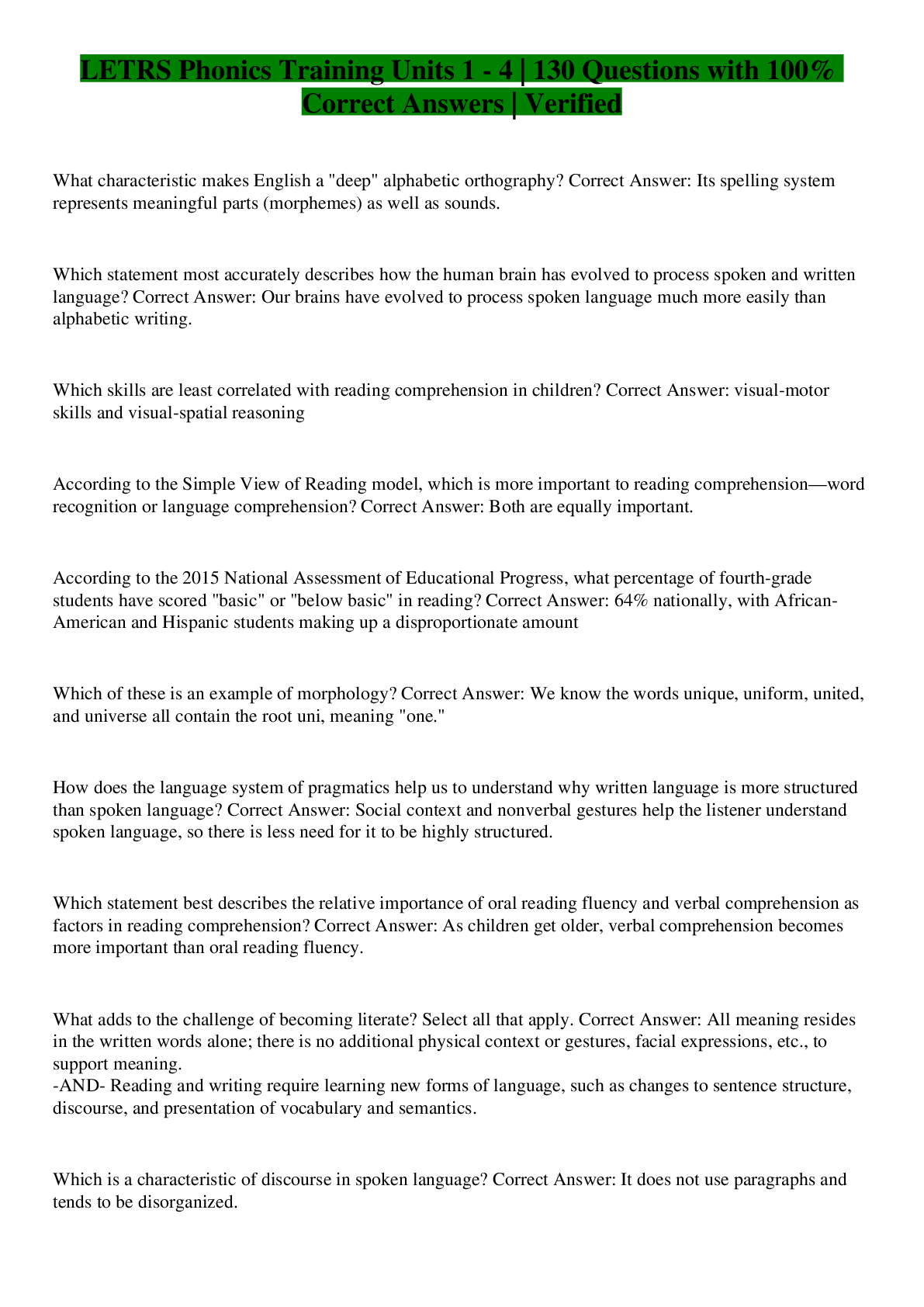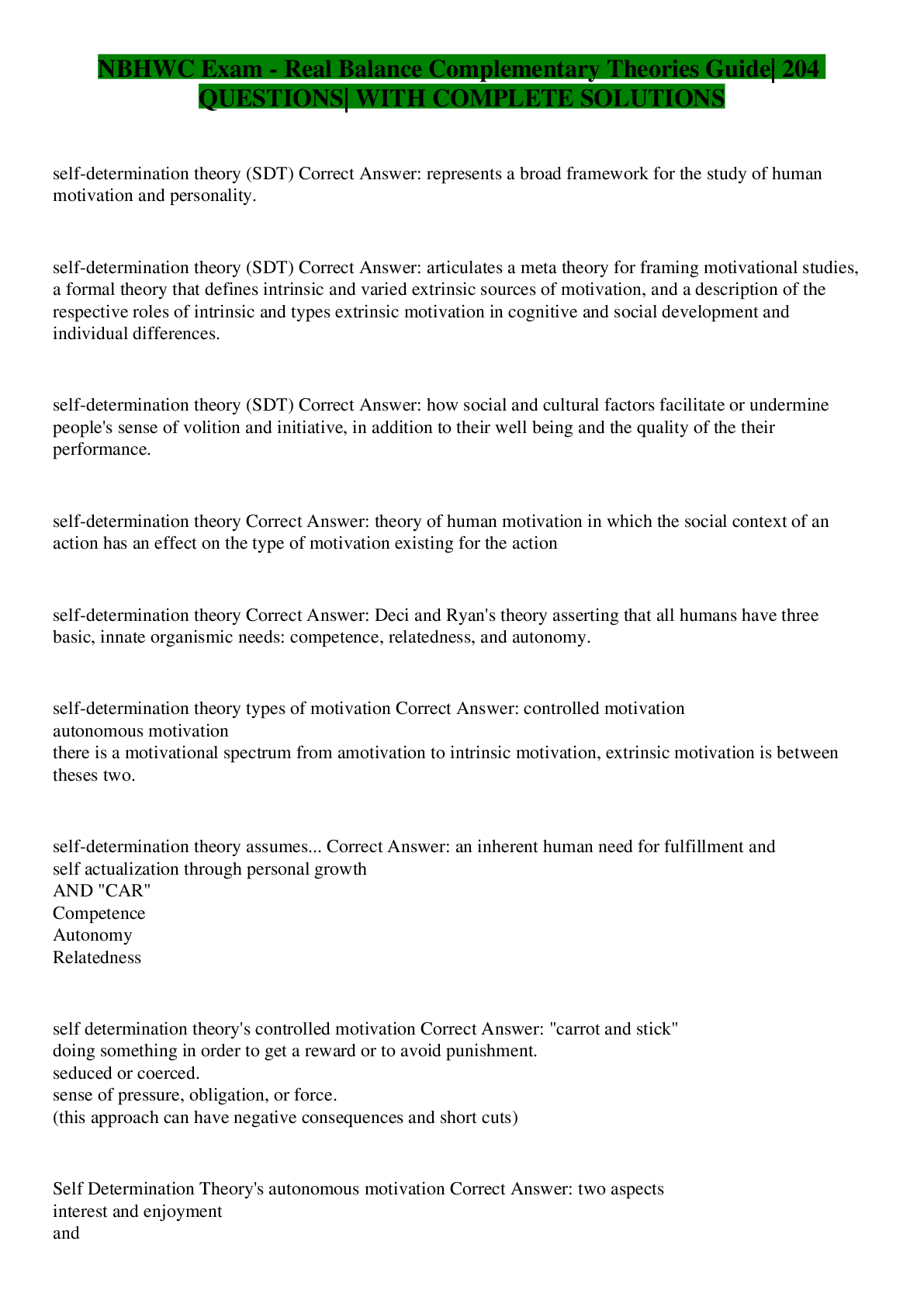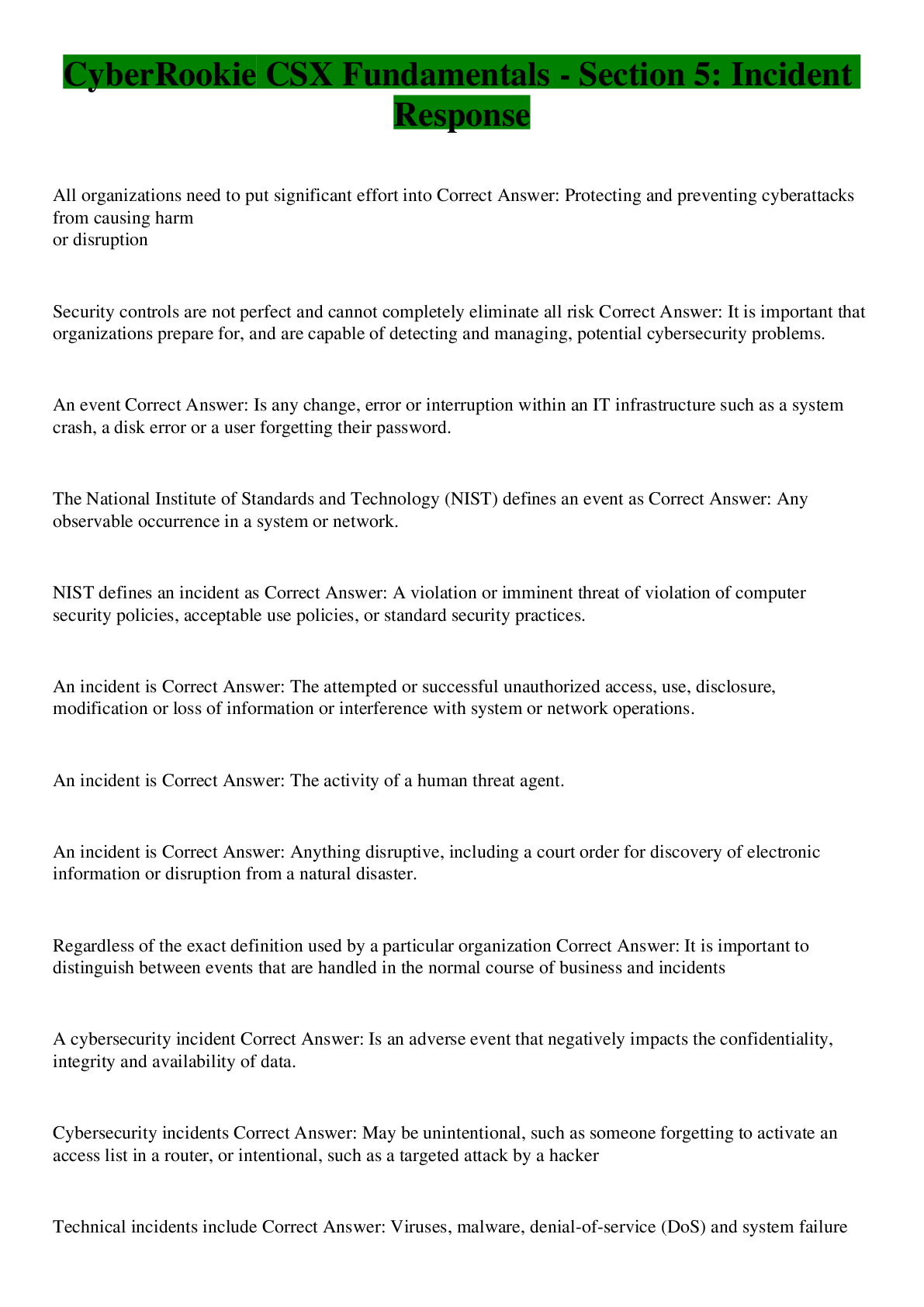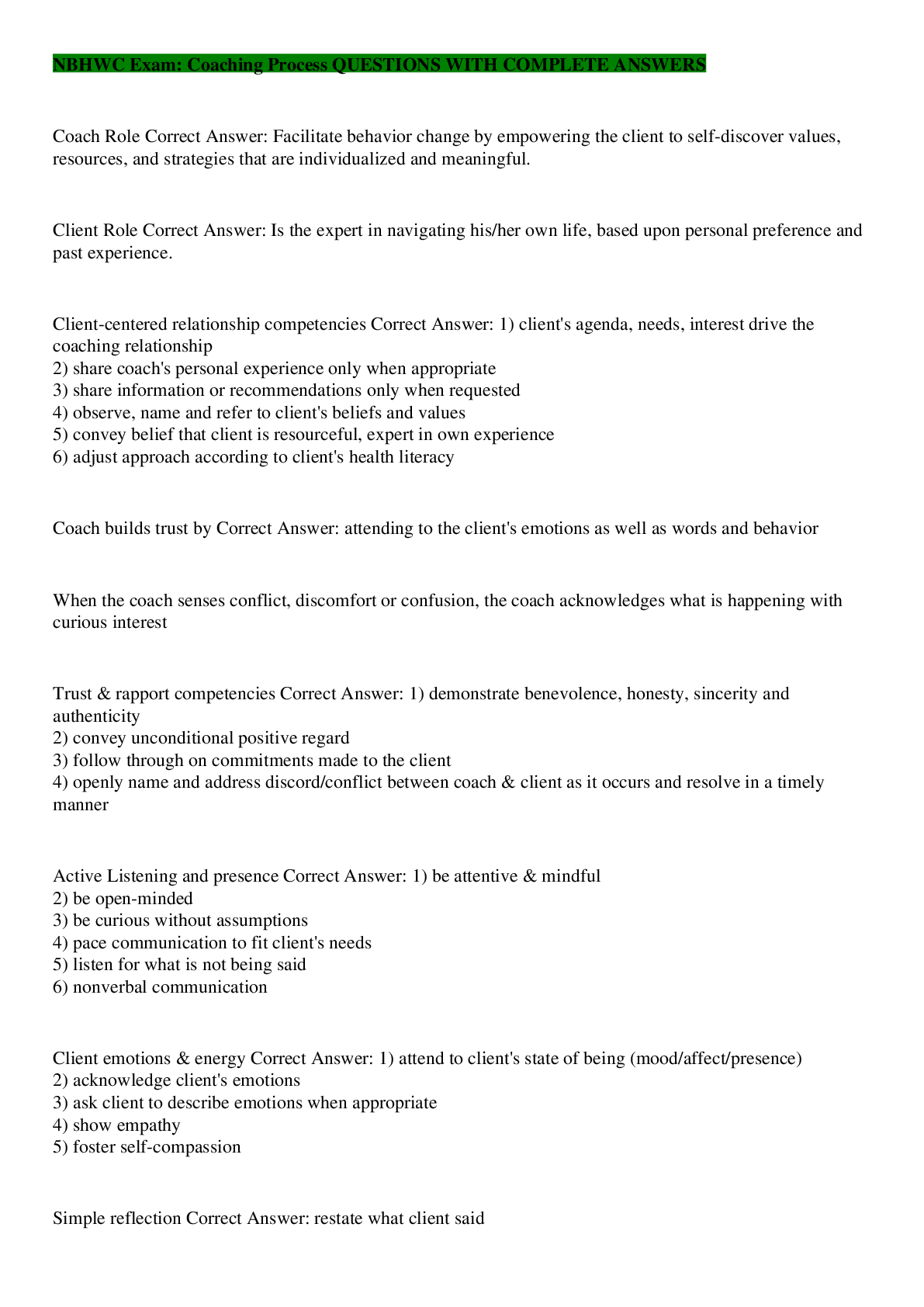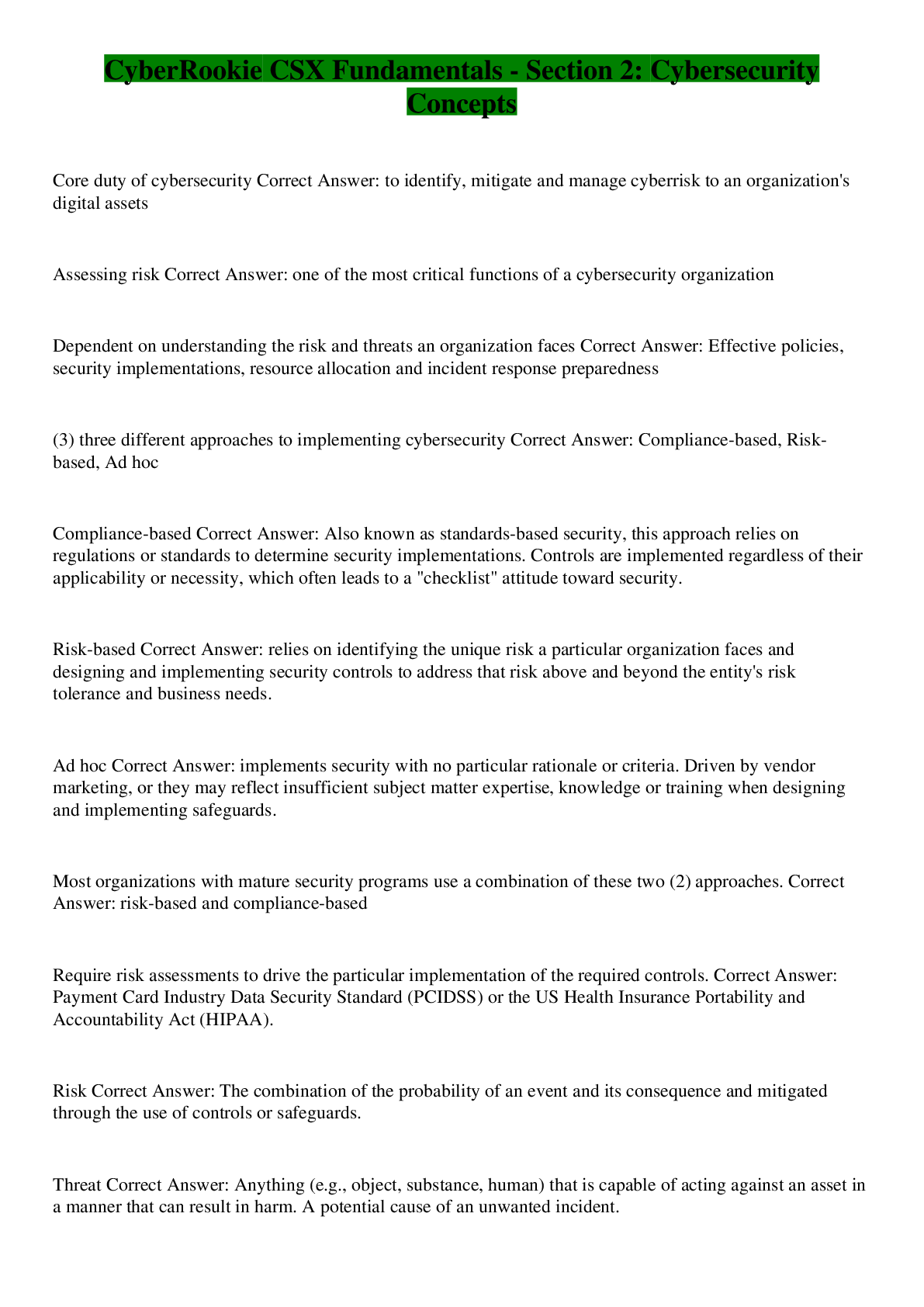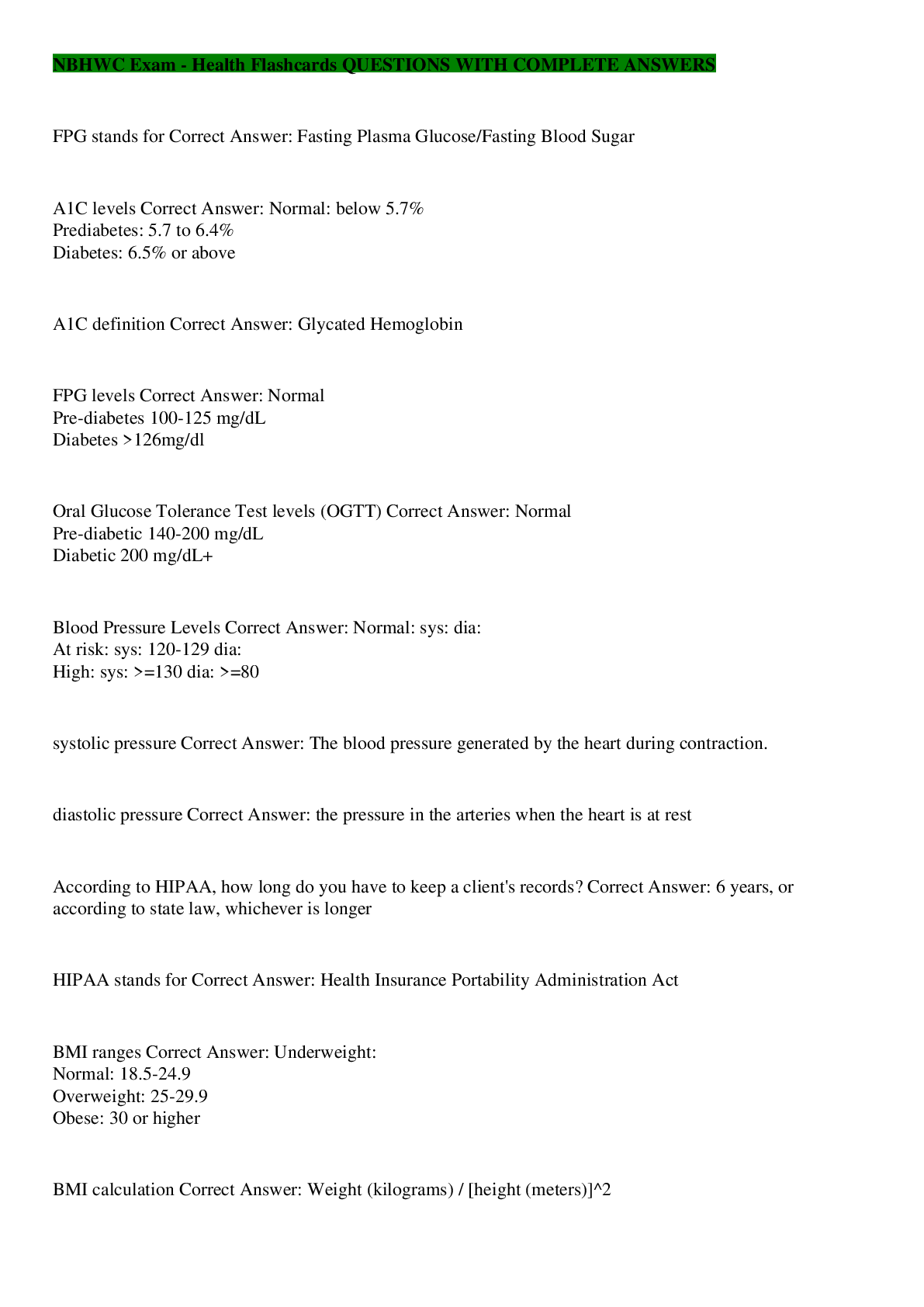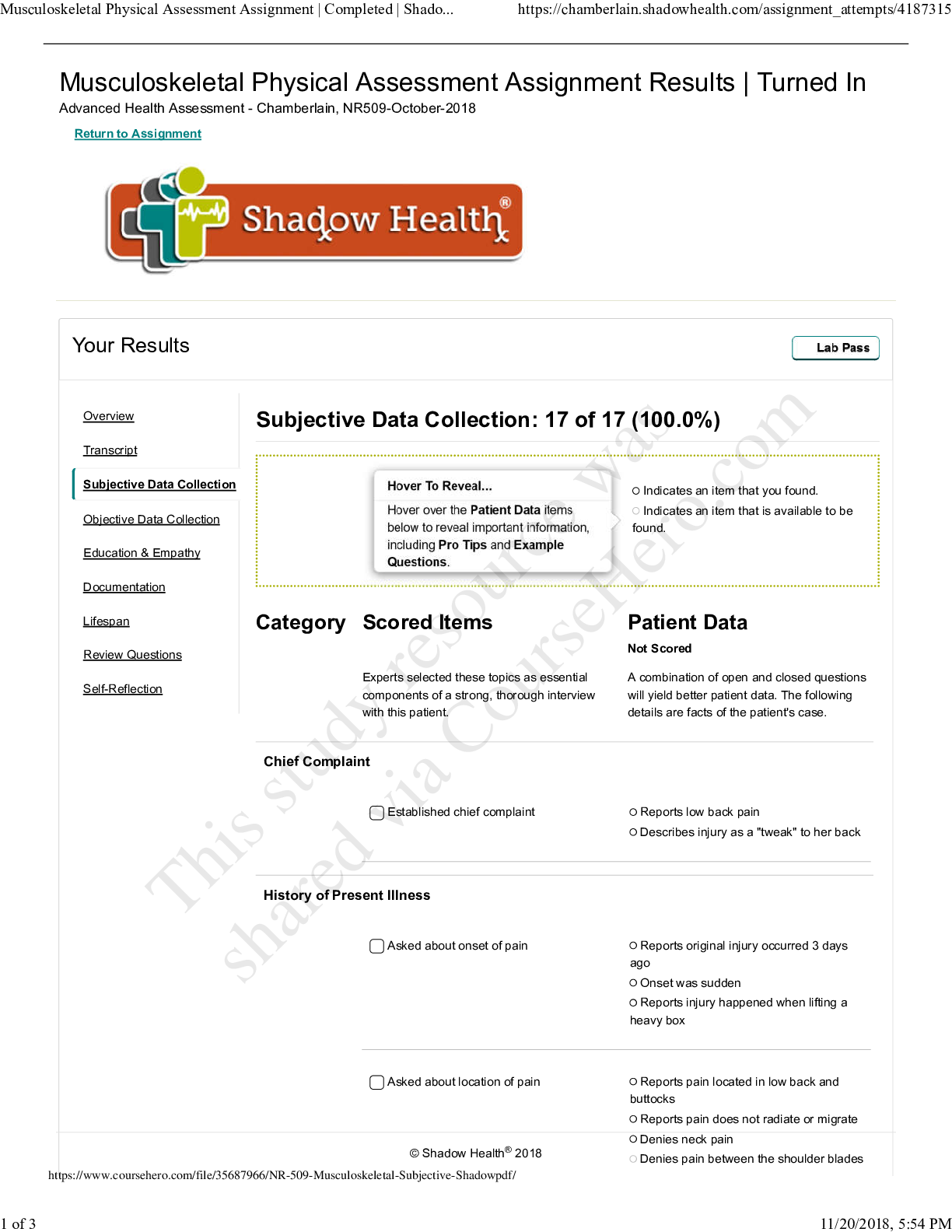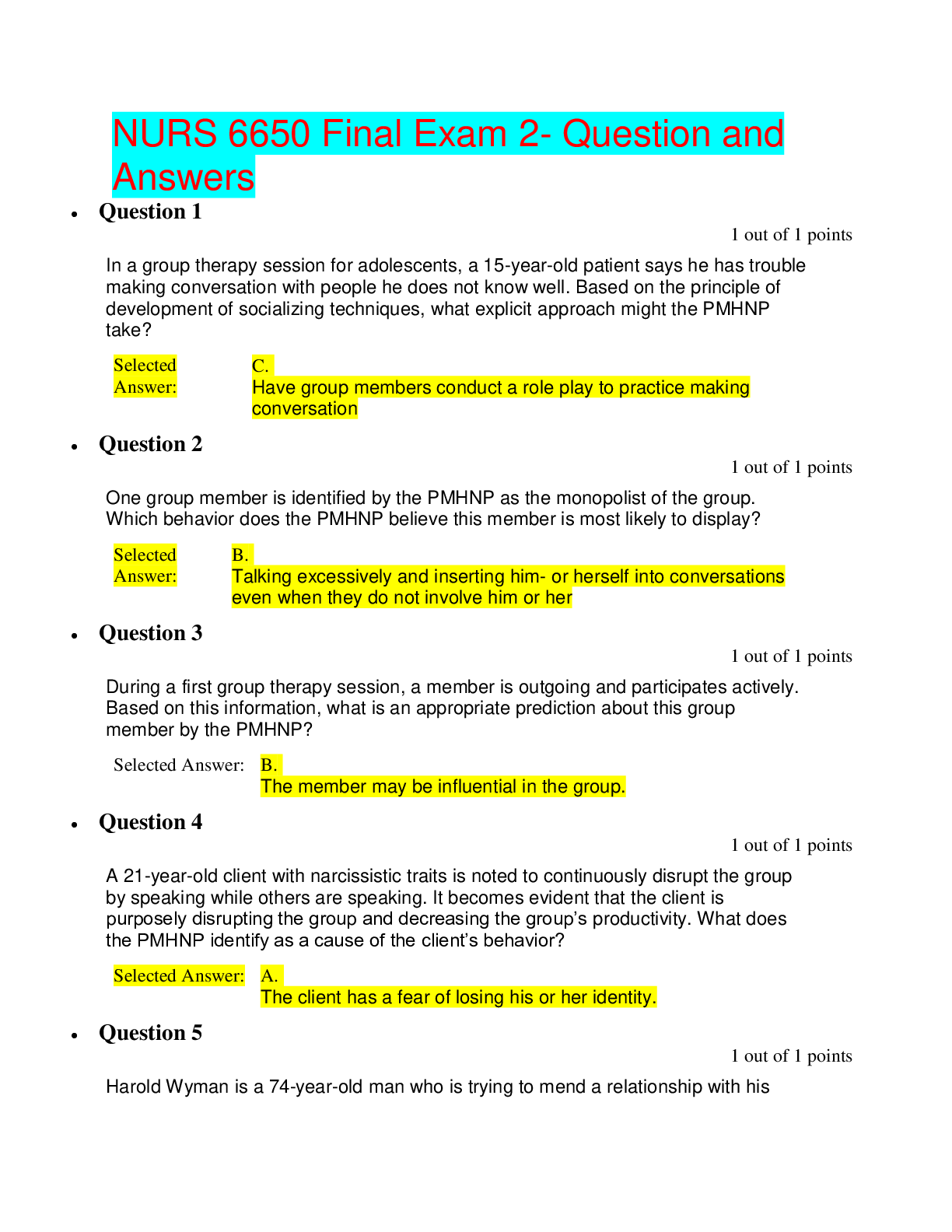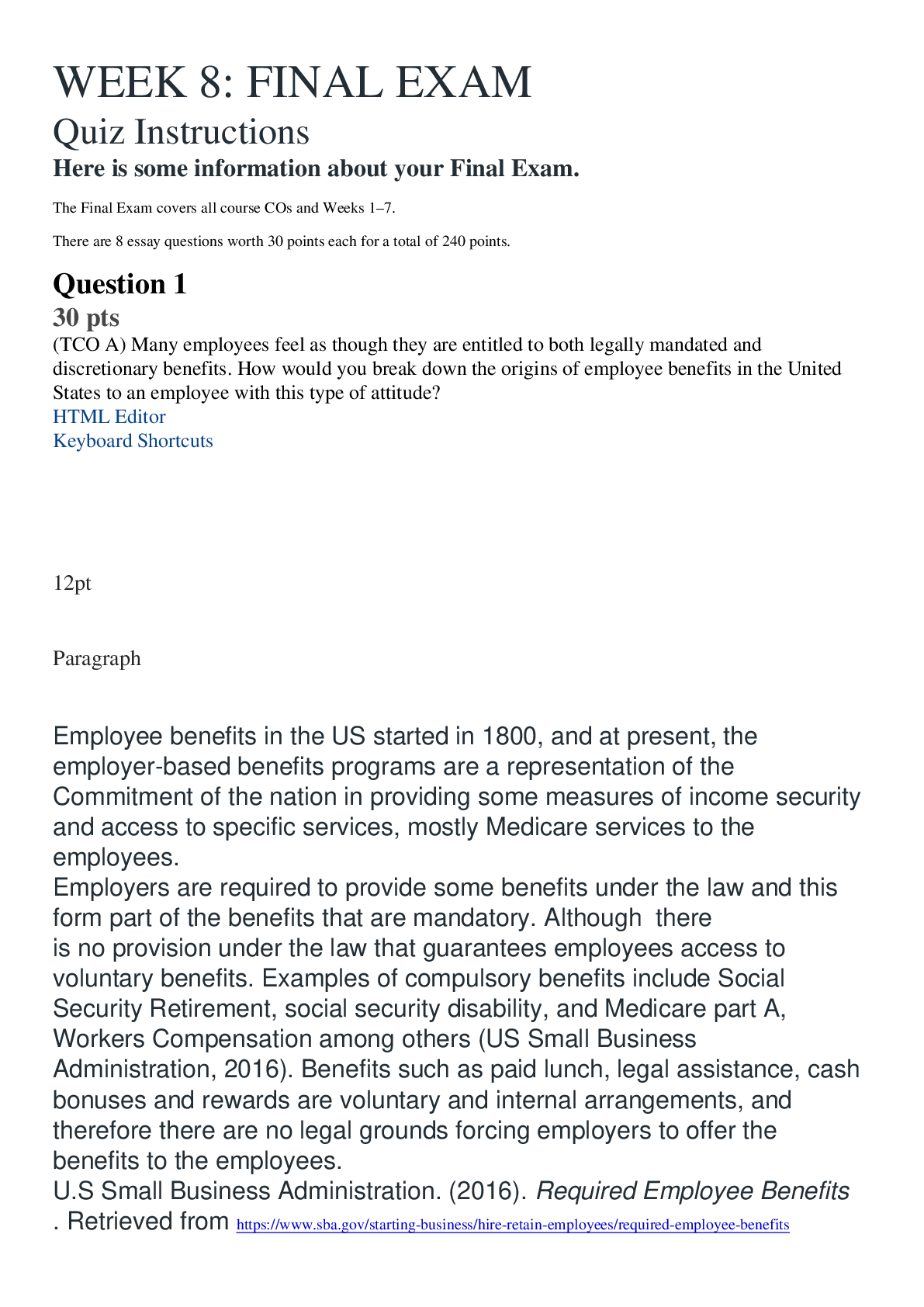Health Care > EXAM > WGU C211 - Global Economics for Managers QUESTIONS AND ANSWERS 100% CORRECT (All)
WGU C211 - Global Economics for Managers QUESTIONS AND ANSWERS 100% CORRECT
Document Content and Description Below
WGU C211 - Global Economics for Managers Views on Globalization Ans: New, Evolutionary, and Pendulum "New" view on globalization Ans: A force sweeping through the world in recent times. "Ev... olutionary" view on globalization Ans: A long-run historical evolution since the dawn of human history "Pendulum" view on globalization Ans: One that swings from one extreme to another from time to time Foreign Direct Investment Ans: Direct investment in, control, and management of value-added activities in other countries Political views on FDI Ans: Radical View, Free Market View, Pragmatic Nationalism Benefits to a country receiving FDI Ans: Capital Inflow, Technology Spillover, Advanced Management Know-How, Job creation Costs to a country receiving FDI Ans: Loss of Sovereignty, Adverse effects on competition, Capital outflow. How do resources and capabilities influence the competitive dynamics of a business? Ans: Resource similarity and market commonality can yield a powerful framework for competitor analysis. Resource similarity Ans: The extent to which a given competitor possesses strategic endowment comparable, in terms of both type and amount, to those of the focal firm. How does resource similarity impact competitive dynamics? Ans: Firms with a high degree are likely to have similar competitive actions. (Starbuck's instant coffee & McDonald's iced coffee) Classical theories of international trade Ans: Mercantilism, Absolute advantage, and Comparative advantage Modern theory view Ans: Dynamic Classical theory view Ans: Static Absolute advantage Ans: The economic advantage one nation enjoys that is superior to other nations Comparative advantage Ans: The advantage one economic activity nation enjoys in comparison with other nations (relative, not absolute) Mercantilism Ans: A theory that suggests that the wealth of the world is fixed and that a nation that exports more and imports less will be richer. Features of the product life cycle? Ans: New, Maturing, and Standardized Strategic trade Ans: Intervention by governments in certain industries can enhance their odds for international success. How are supply and demand related to the exchange rate of a country? Ans: The price of a commodity, a country's currency, is fundamentally determined by this. Strong demand leads to price hikes; oversupply results in price drops. Which theory came first? Ans: Mercantilism (although both are of the idea that governments should actively protect domestic industries from imports and vigorously promote exports) If a company seeks to limit foreign exchange rate exposure in the forward direction, what is the most effective way to do this? Ans: Forward transactions, an act know as currency hedging. Transaction risk Ans: The exchange rate risk associated with the time delay between entering into a contract and settling it. Hedging Ans: A transaction, such as forward transactions, that protects traders and investors from exposure to the fluctuations of the spot rate. Currency hedging Ans: A way to protect traders and investors from being exposed to the fluctuations of the spot rate Strategic hedging Ans: A means of spreading out activities in different currency zones in order to offset the currency losses in certain regions through gains in other regions (currency diversification) First mover advantages Ans: Proprietary, technological leadership, pre-emption of scarce resources, establishment of entry barriers to late entrants, avoidance of clash with dominant firms at home, relationships with key stakeholders, (such as governments.) Late mover advantages Ans: Opportunity to free ride on first-mover investments, Resolution of technological and market uncertainty, First mover's difficulty to adapt to market changes.) Foreign market entries types Ans: Non-equity and equity Non-equity Ans: Reflects relatively smaller commitments to overseas markets. Determines firms MNE status. Equity Ans: indicative of relatively larger, harder-to-reverse commitments. Determines firms MNE status. How do institutions reduce uncertainty? Ans: Establish "rules of the game" that economic players play by. A standard to follow in order to survive and prosper. By signaling which conduct is legitimate and which is not, institutions constrain the range of acceptable actions. Regulatory pillar Ans: The coercive power of governments (laws, regs, rules) Normative pillar Ans: Values, beliefs, and actions of other relevant players (norms, cultures, ethics) Cognitive pillar Ans: The internalized, taken-for-granted values and beliefs that guide behavior. (beliefs between right/wrong) Formal institution Ans: One that include laws, regulations and rules Informal institution Ans: One that includes norms, cultures and ethics What core propositions lie at the root of the institution based view on global business? Ans: (1) managers and firms rationally pursue their interests and make choices within institutional constraints (bounded rationality) (2) in situations where formal constraints are unclear or fail, informal constraints play a larger role in reducing uncertainty and providing constancy to managers and firms (personal relationships and connections) The institution based view global business is grounded upon Ans: The dynamic interaction between institutions and firms, and considers firm behaviors as the outcome of such an interaction. How is global business affected by democracy? Ans: An individual's right to freedom of expression and organization. For example, starting up a firm is an act of economic expression How is global business affected by totalitarianism? Ans: These countries often experience wars, riots, protests, chaos, and breakdowns, which result in higher political risk. Democracy Ans: Citizens elect representatives to govern the country on their behalf. Totalitarianism Ans: One person or party exercises absolute political control over the population. Civil law Ans: Law that uses comprehensive statutes and codes as a primary means to form legal judgments. Common law Ans: Law shaped by precedents and traditions from previous judicial decisions. Theocratic law Ans: A legal system based on religious teachings. How do civil, common and theocratic laws compare? Ans: Relative to civil law, common law has more flexibility because judges have to resolve specific disputes based on their interpretation of the law. Civil law has less flexibility because judges only have the power to apply the law. Property right Ans: The legal rights to use an economic resource and to derive income and benefits from it. Can be used as collateral for starting a firm; not as common in developing countries, therefore hindering economic growth. Intellectual property right Ans: Rights associated with the ownership. They primarily include rights associated with patents, copyrights, and trademarks. Market economy Ans: One that is characterized by the "invisible hand" of market forces-all factors of production should be privately owned. Command economy Ans: One that is defined by a government taking all factors of production to be government-owned or state-owned, and all supply, demand, and pricing are planned by the government. Mixed economy Ans: One has elements of both a market economy and a command economy. It boils down to the relative distribution of market forces versus command forces. Indifference curve Ans: A curve that shows consumption bundles that give the consumer the same level of satisfaction (i.e. combinations of pizza and Pepsi with which the consumer is equally satisfied.) Four properties of an indifference curve Ans: (1) Higher indifference curves are preferred to lower ones. People usually prefer to consume more goods rather than less. (2) Indifference curves are downward sloping. The slope of an indifference curve reflects the rate at which the consumer is willing to substitute one good for the other. (3) Indifference curves do not cross. (4) Indifference curves are bowed inward. The slope of an indifference curve is the marginal rate of substitution—the rate at which the consumer is willing to trade off one good for the other. Marginal rate of substitution. Ans: The rate at which the consumer is willing to trade off one good for the other (i.e. how much Pepsi the consumer requires to be compensated for a one-unit reduction in pizza consumption) Budget constraint Ans: The consumption bundles that the consumer can afford. How might a budget constraint be impacted by an increase in income? Ans: Additional bundles could be consumed with an increase in income. [Show More]
Last updated: 1 year ago
Preview 1 out of 12 pages
Instant download
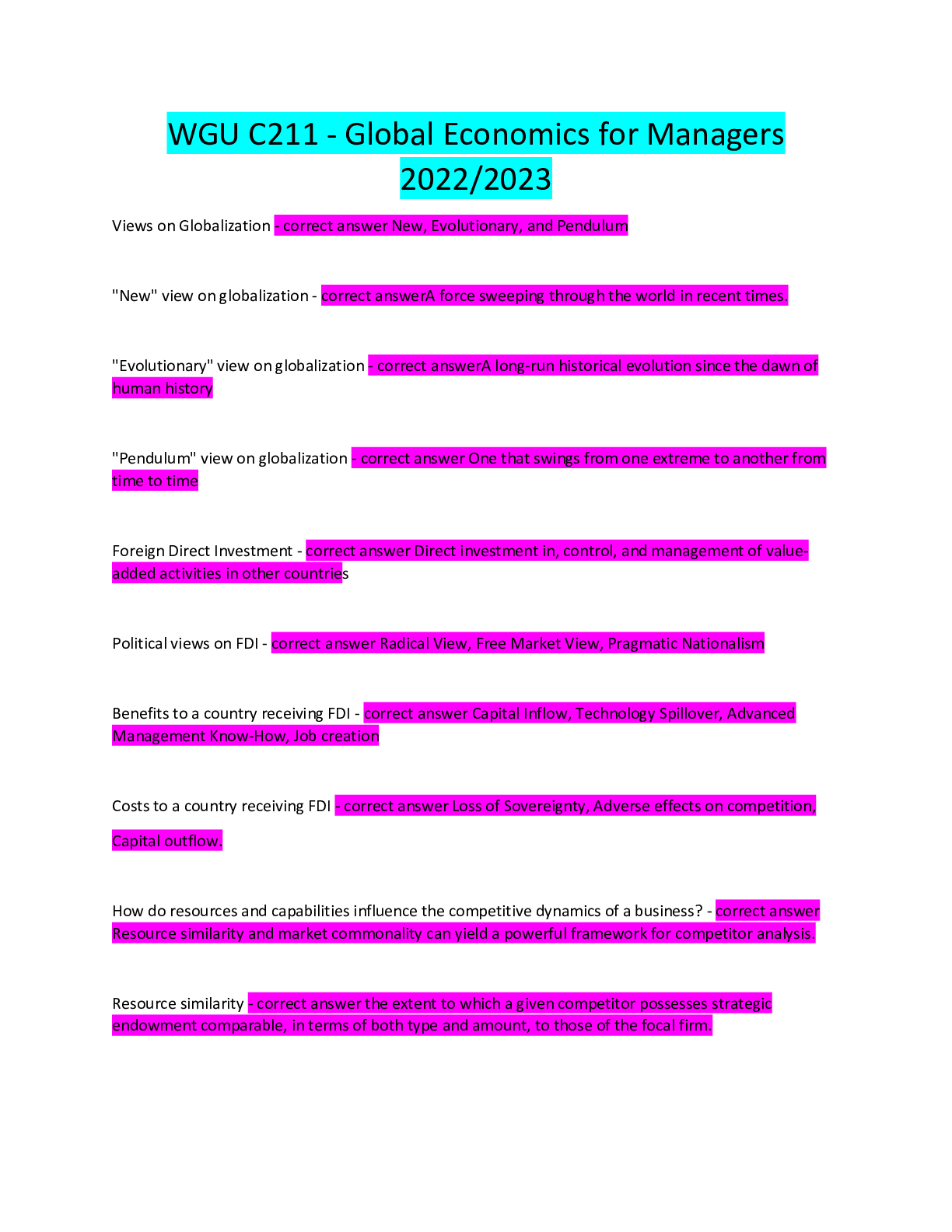
Buy this document to get the full access instantly
Instant Download Access after purchase
Add to cartInstant download
Reviews( 0 )
Document information
Connected school, study & course
About the document
Uploaded On
Sep 16, 2022
Number of pages
12
Written in
Additional information
This document has been written for:
Uploaded
Sep 16, 2022
Downloads
0
Views
20


